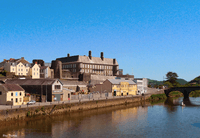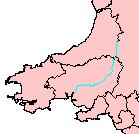River Tywi facts for kids
Quick facts for kids River Tywi |
|
|---|---|

River Tywi at Carmarthen
|
|

Course of the River Tywi
|
|
| Cities | Llandovery, Llandeilo, Carmarthen |
| Physical characteristics | |
| Main source | Cambrian Mountains (SN802631) 488 m (1,601 ft) |
| River mouth | Carmarthen Bay |
| Length | 120 km (75 mi) |
| Basin features | |
| Basin size | 515 km2 (199 sq mi) |
The River Tywi (called Afon Tywi in Welsh) is the longest river that flows completely within Wales. It stretches for about 120 kilometers (75 miles). This river is famous for its great sea trout and salmon fishing.
Contents
Where Does the River Tywi Flow?
The Tywi starts high up in the Cambrian Mountains, about 15 kilometers (9 miles) from where the River Teifi begins. It flows through the steep hills of the Tywi Forest. Here, it forms the border between Ceredigion and Powys. The river then generally flows southwest through Carmarthenshire. It passes through the towns of Llandovery and Llandeilo.
The Tywi is 120 kilometers (75 miles) long and has many smaller rivers joining it. These smaller rivers are called tributaries. Some of its tributaries include the Cothi, Gwili, Brân, and Doethie. Near Carmarthen, a large tributary called the Afon Gwili joins the Tywi at Abergwili. The river then widens into an estuary (where the river meets the sea). It flows into Carmarthen Bay along with the River Taf and the two branches of the River Gwendraeth. Llansteffan Castle, a castle built by the Normans in the 12th century, once guarded this estuary.
How the Tywi River Was Dammed
About 10 kilometers (6 miles) from where it starts, the fast-flowing Tywi is stopped by the Llyn Brianne reservoir. This reservoir was created in 1972 by building a dam across the river. The dam helps store winter rain. This stored water is then released into the river during dry times. This helps keep the river flowing. The reservoir also helps provide drinking water to a large part of southeast Wales. Without the water released from the reservoir, the river would not be able to supply so much drinking water.
Animals and Plants of the Tywi
Fish in the River Tywi
The Tywi is a very popular place for catching large sea trout. These fish are a type of brown trout that live in the sea but come into the river to breed. They enter the river every spring and early summer. The Tywi is believed to produce more sea trout weighing over 5 kilograms (10 pounds) than any other river in Britain. Anglers (people who fish) have caught these fish weighing over 20 pounds.
In summer and autumn, many Atlantic salmon also swim up the river. In May, the Tywi also sees a run of the rare and protected twaite shad and allis shad. Other fish found in the Tywi include brown trout, eels, pike, and various small fish. It is also home to brook lampreys, river lampreys, and sea lampreys.
The Tywi holds a special record for the biggest fish ever caught with a rod and line in fresh water in Britain. This was a sturgeon that weighed 176 kilograms (388 pounds) and was 2.8 meters (9 feet 2 inches) long! It was caught in the river near Nantgaredig in 1932.
Mammals Living Near the Tywi
The Tywi has a healthy population of otters. Many other common mammal species also live there. Grey seals are often seen in the lower parts of the river. They sometimes swim several miles upstream to hunt for sea trout and salmon.
Birds of the Tywi Valley
The Tywi and the valley around it (called Dyffryn Tywi) are home to a wide variety of water and wetland birds. Some of the special birds found along the river include sand martins, common sandpipers, little ringed plovers, dippers, kingfishers, and grey wagtails. Red kites and buzzards are also very common. Goosanders and cormorants hunt for sea trout and salmon in the river.
Plants of the Tywi Valley
The Tywi valley has many oxbow lakes. These are U-shaped lakes formed when a wide bend of a river is cut off from the main river. These lakes offer beautiful sights throughout the year. In summer, at Bishop's Pond in Abergwili (an oxbow lake formed in 1802), you can see a stunning display of yellow water lilies when the water level is low. The edges of the pond are fringed with reed sweet-grass. This plant is also found in other parts of Wales, like the Teifi valley, Gower, Powys, Anglesey, and along the North Wales coast.
See also
 In Spanish: Río Towy para niños
In Spanish: Río Towy para niños


